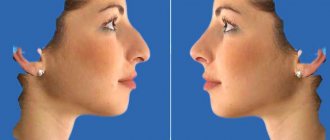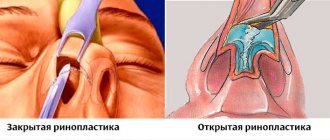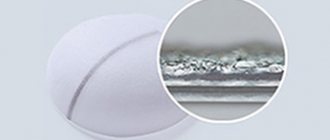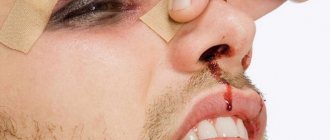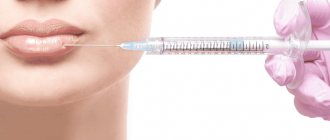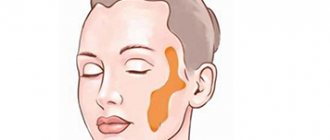COST OF RHINOPLASTY (PRICE):
The cost of the operation depends on the type of problem and the amount of work performed. Plastic surgeons conventionally distinguish several types of operations: correction of the end section (plasty of the tip or wings of the nose); rhinoseptoplasty (correction of the nasal septum) and full volume rhinoplasty.
RHINOPLASTY AT THE PIROGOV CLINIC IS AN OPERATION IN THE BEST PLASTIC SURGERY CLINIC IN ST. PETERSBURG.
*according to the ratings of the portals “Doctor Peter” and “Fontanka.ru” in 2021. Read more.
Interview with plastic and reconstructive surgeon, president of ROPREH Konstantin Borisovich Lipsky.
Implant materials for rhinoplasty: what takes root and what is rejected
The nose is a very capricious structure. Nasal implants made from any foreign materials, as a rule, take root very poorly. A lot of options have been tried: gold, platinum, ivory, paraffin, plexiglass, all types of silicone implants. Unfortunately, neither material has proven itself satisfactorily.
Silicone
implants in people with European skin type almost always cause protrusion (bulging), and the implant comes out through the skin. In patients with an Asian face type, medical silicone lasts longer and has proven itself better.
Medpor implants
highly depends on the depth and accuracy of installation. If the surgeon is not experienced enough in such work, the risk of protrusion is also high.
Allogeneic grafts (cartilage taken from donors)
get along better. But due to new laws, difficulties arose with their production and registration. In addition, when using donor cartilage, complications such as cartilage resorption, toxic poisoning, and infection often occurred. Any foreign body that enters the body increases the risk of bacterial infection.
Allogeneic fascia, a processed donor (cadaveric) material, has been used for a long time and with good results. But, firstly, this is a very expensive option, and secondly, you can always take the patient’s own fascia.
Either temporal fascia (temporal fascia) or retroauricular fascia is used, or, when harvesting costal cartilage, a piece of fascia can be taken from the rectus abdominis muscle.
Own fabric
– ideal and most often used material. Ear cartilage can be used to add volume, camouflage defects, and also for minor saddle deformities or deformities of the nasal alae. Due to its softness, it is not suitable for reconstructing the supporting structures of the nose. However, in all other cases it is the best and most readily available source of cartilage for rhinoplasty.
Nasal septum
is also a cartilage donor zone. However, the amount of cartilage in it is limited, since the septum is a necessary part of the nose. Collection is carried out only from the posterior sections. To maintain the structural strength of the septum, its anterior section must remain large enough, otherwise after some time aesthetic complications will arise: saddle-shaped deformation in the cartilaginous section, curvature of the nose.
Some patients have a very crooked septum, very thin skin and very thin – literally paper-thin – cartilage. In such cases, the risk of complications is increased, so you need to either duplicate the septum (stitched with donor cartilage) or use costal cartilage. If, at the stage of planning the operation, the surgeon sees that there may not be enough septal cartilage, he warns the patient in advance about the possibility of harvesting the costal cartilage.
Collection and suturing of the wound takes about an hour, which significantly increases the operation time. We typically harvest the cartilage with a second team, so the operating time is not prolonged. Unfortunately, not everyone can afford this approach.
Costal cartilage sampling, approaches, installation methods
For reconstruction, a small piece of cartilage from the vagus rib is usually sufficient. With the endoscopic technique, the incision can be very small, about 1 cm. If the patient has already had breast prosthetics, the sampling can be done through the previous access, avoiding unnecessary scars.
Previously, cartilage was often installed in the bridge of the nose as a single piece. In this option, there is always a danger of deformation, since the costal cartilage is under severe stress and will always tend to bend and take its previous shape.
In case of a large amount of deformation and/or significant lack of the back, chopped cartilage wrapped in fascia, the so-called DCIF (diced cartulage in fascia), is installed. In this way, the entire length of the nasal dorsum can be increased, with the caudal part of the DCIF placed under the lateral crura of the alar cartilages, which promotes their rotation into a more physiological position.
To reconstruct the tip of the nose, supporting and structural autografts are used to strengthen the cartilaginous structures of the tip of the nose, which are formed directly during the operation.
If cartilage needs to be installed cut (with notches), it is important not to deform it in the process: cartilage has shape memory and in the future will tend to bend in an unnecessary way.
Some surgeons still use the following method: the cartilage is placed in a machine that acts as a press, flattened and turned into pulp, which can then be used to camouflage the back. This option is outdated and very dangerous. When broken, crush syndrome is formed, so the cartilage will be destroyed even after rhinoplasty. Histological examination of such cartilages shows traces of foci of necrosis.
Contouring and resorption of cartilage
To prevent the cartilage from contouring, it must be covered very well. The cartilage placed under the fascia will not be visible at all. Or, if the cartilage required is too thick and cannot be additionally covered with fascia, you should not leave sharp edges that could contour.
Cartilage is nourished, among other things, by the blood supply to the skin. It is very important that the skin is not thin and has good blood supply. However, there is not much covering tissue in the dorsum of the nose, so great care must be taken when using chopped or finely chopped cartilage (which can still contour). One of the complications when using cartilage is this contour deformation. But, fortunately, it is very easily eliminated (in the postoperative period, corticosteroid injections are given in a minimal dosage).
Resorption of cartilage occurs in exceptional cases. For example, if a secondary infection occurs and inflammation occurs. This happens extremely rarely and, as a rule, is easily stopped. I have not seen such cases in my practice.
Under normal conditions, cartilage does not dissolve. For some time it feeds from the environment, and then vessels grow between the sections of cartilage, and it begins to be supplied with blood again. If the processes of tissue regeneration around the cartilage proceed calmly, even the cartilage wrapped in fascia does not undergo degenerative processes, remaining alive and active.
There are no other side effects of using your own cartilage for nasal reconstruction.
Aesthetic possibilities of reconstruction. Will it be possible to make your nose thin and graceful?
When reconstructing the nose after injury, the outcome depends on how severe the injury was and how much tissue was lost. If you plan to use fascia, you can use less cartilage to create a thinner nose. But it is impossible to calculate the shape exactly, since the course of the operation is influenced by many factors. If after surgery the body reacts with significant scarring, it is difficult to predict the nuances. Any change of 1 millimeter entails a change in the entire appearance of the nose.
Symmetry is achieved by shaping the nose during surgery (“sculpting”) and securely fixing the bandage. Plaster plays a very important role, it can directly affect the width of the nose. Very often, especially with secondary rhinoplasty, the back becomes wider over time, and the patient begins to think that, apparently, he did not have an osteotomy. And during the correction it turns out that the problem is more scarring in the area of the slopes of the nose. And after removing these scars, you get the same shape that the previous surgeon did. Usually in such cases there was a small splint as a bandage, or the plaster was fixed with a plaster, that is, the fit was loose. This means that the tissues were filled with blood, which over time is replaced by connective tissue, which gives excess volume and/or deformation. So plaster is very important not only to prevent the displacement of bone fragments after surgery, but also as a factor in influencing the shape of the nose.
I use a cast that is also fixed to the forehead. In my opinion, this is the most reliable way.
1 week of wearing is enough for the bones to grow together. If there was a lot of skin, plaster will help reduce it and reduce the degree of post-operative swelling.
Further swelling appears due to the fact that microcirculation and lymphatic drainage have not yet been restored. There are no clear rules, but usually after primary rhinoplasty, swelling goes away within 6 months. At the same time, the skin can “sit down” even for a year. And after secondary rhinoplasty, when the blood supply is disrupted, recovery can take much longer, but these floating, unstable swelling will no longer affect the shape of the nose.
Most deformities that occur in the postoperative period are associated with the growth of connective tissue or periosteum. In particular, the so-called residual hump, which appears several months after the operation. The patient must be monitored for up to a year during secondary operations. The surgeon must monitor how the skin, subcutaneous tissue, and connective tissue behave. Sometimes a corticosteroid injection is required to reduce the amount of tissue that has grown.
To communicate with patients who have undergone rhinoplasty, come to our forum, Rhinoplasty section
TYPES OF RHINOPLASTY:
Surgery on the wings of the nose
allows you to correct the thickness and shape of the outer walls of the nostrils. Among all plastic surgeries on the nose, correction of the wings is the most gentle, but most often it is indicated in combination with other surgical procedures to improve the shape of the nose.
Crook in the nose
is a source of complexes about his appearance. And here plastic surgery (rhinoplasty) is a real opportunity to come into harmony with one’s own reflection in the mirror. An imperfect nose shape may be genetically determined or may be the result of a previous injury.
Rhinoplasty of the tip of the nose
always requires a high level of skill from the surgeon, since in each specific case the operation follows a unique scenario. The surgeon must take into account many points - the thickness of the skin at the tip of the nose, the size of the nose, the density of cartilage and much more. To correct the tip of the nose, depending on the specifics of the task, a closed or open surgical method is selected.
In the first case (closed rhinoplasty)
the doctor makes incisions inside the mucosa, which allows you to avoid visible postoperative scars, but the surgeon is limited in the choice of professional techniques.
In the second case (open rhinoplasty)
he has more possibilities, and moreover, he can control the process more tightly: the surgeon sees the entire surgical field, working with the pterygoid cartilages and applying sutures, the likelihood of errors is minimized.
Rhinoseptoplasty
is an operation that involves the surgical elimination of defects in the nasal septum. The operation is recommended when there is difficulty in nasal breathing; chronic runny nose, nasal congestion, sinusitis, sinusitis and even snoring.
It hurts?
Rhinoplasty, regardless of the type, is always performed under anesthesia. Therefore, the operation process will be completely painless. The postoperative period may be accompanied by painful sensations. The pain can be aching, throbbing, pulling, but not sharp. In this case, the doctor prescribes an anesthetic drug. Inconveniences during the recovery period can cause other consequences. Such as:
- the appearance of hematomas and edema,
- obligation to regularly change dressings, treat sutures with medications,
- You may have to breathe through your mouth.
All these unpleasant consequences disappear within 3-7 days. But then, the nose of your dreams is guaranteed.
INDICATIONS FOR RHINOPLASTY
Most often, rhinoplasty is used to eliminate congenital features or acquired defects:
wide or crooked nasal bridge;
· deformation of the nose and breathing problems after injury;
· long or too thick tip of the nose;
· disproportionately large nose;
· excessive hump;
· nostrils that are too wide or open.
The development of plastic surgery and modern surgical techniques have allowed many people to breathe deeply after rhinoplasty. The surgeons of our clinic will select the necessary treatment for you, based on the specific problem and individual characteristics of the body.
Nose modeling before rhinoplasty
When going to a rhinoplasty center, people don’t always know exactly what kind of nose they want to end up with.
Almost 80 percent of patients come to immediately restore normal nasal breathing and get rid of congenital or acquired defects of the nose that spoil the appearance. Only a small percentage of people who turn to a plastic surgeon have a standard of beauty that they want to meet.
3D modeling makes it possible to see from different angles how the new nose will look after postoperative rehabilitation is completed.
A special program helps not only to take into account any wishes of the patient, but also objective physical data obtained, for example, during an x-ray examination, so that the nose fits perfectly into the parameters of the face.
Virtual modeling of a new look before rhinoplasty
The patient, working together with a rhinoplasty specialist, creates a new profile for himself, turning a routine consultation into a creative process.
- The parameters that aesthetically influence the shape are determined.
- Any wishes of the patient are taken as a basis, and a new profile is selected along with it.
- The 3D modeling program makes it possible to see how the nose will change after surgery.
- Any changes to shape, size, configuration are made on the monitor screen.
Working together allows you to select the future appearance as accurately as possible, and then the plastic surgeon chooses the optimal technique for the upcoming rhinoplasty.
Important!
Creating a new appearance using preliminary modeling greatly simplifies the surgeon’s work by helping to understand in advance what the new nose will look like and what needs to be corrected so that the corrected appearance is completely satisfactory to the patient.
At the modeling stage, the patient, together with the doctor, makes a decision that determines future changes in appearance. This way, the risk of mistakes being made when changing the shape of the nose is minimized.
Each patient receives pictures of a 3D model from different angles, so that after completion of the rehabilitation process they can compare with the result obtained.
Features of computer modeling for rhinoplasty
You should not expect that the image created during computer modeling can be easily transferred to a real person. There are nuances that affect the final result that should be kept in mind.
- Individual characteristics of the body.
- Thickness, type of epidermis. Condition of the bone base.
- The need to strengthen cartilage with a graft.
- Age-related changes in the structure of the nose.
- Features of the facial structure of a particular person.
- The rate of scarring of sutures and skin regeneration.
The doctor must take into account all risk factors in order to minimize possible problems during plastic surgery.
Important!!!
Preliminary modeling makes it possible to form a new image that ideally matches the anthropometric parameters of a particular person, so that, after carrying out all the manipulations, you will follow the path planned in advance.
The importance of preoperative computer simulation
Most people, seeing the attractive appearance of another person, turn to a plastic surgeon for help, without thinking about how they will look after the changes made. Excessive demands, the desire to blindly follow fashion without taking into account the structural features of your face often causes serious problems in the future.
The 3D model clearly demonstrates how well the selected shape and size correspond to the patient’s personal external data. Correcting flaws and making adjustments on the screen is easier than after surgery.
When visiting a rhinoplasty clinic, people ask for a beautiful nose. At the same time, not taking into account that beauty is a subjective concept. Everyone has their own idea of a beautiful nose shape.
Develop a general strategy. A computer-generated model helps to find the golden mean.
It is difficult for a non-specialist to understand what capabilities modern plastic surgery has. The doctor, working on a new image, easily demonstrates to the patient what he can count on.
What will the nose profile be like after rhinoplasty?
Remember!
It is impossible to completely change the nose. The existing structure of the nose is always taken as a basis. With rhinoplasty, many congenital or acquired defects can be corrected, but complete change is almost impossible.
The model demonstrates what awaits the patient after plastic surgery, and what cannot be done. A plastic surgeon is not a magician. He bases his work on the real parameters and capabilities of the human body, adjusting, improving the configuration, size, and correcting the mistakes of nature.
By working with the surgeon on a new look, the patient gets used to the upcoming changes, psychologically preparing for the operation. Simulation helps to avoid future disappointments because the patient immediately sees how his expectations correspond to reality.
Modeling allows you to look at yourself from the outside through the eyes of another person.
3D modeling capabilities
Digital photos, together with special software, provide a unique tool that opens up new perspectives for practicing plastic surgeons.
On the screen you can instantly
- turn your face in any direction,
- try on the shape, size of the nose,
- see how well it will correspond to the anthropometric features of the structure of a given person.
- understand how the new shape fits with the rest of your facial features.
Some patients, after being shown the resulting model, refuse rhinoplasty, realizing that it is impossible to obtain the desired result, or that the new shape of the nose will affect the individual characteristics of the image.
Using interactive scanning, you can place two options for clarity in order to see with your own eyes what changes will happen, what the face will look like after rhinoplasty.
Algorithms used in computer modeling
- Several photographs are taken from different angles using a high-resolution digital camera.
- Using a graphic editor, the resulting images are loaded into a special computer program.
- The painstaking work of the rhinoplasty surgeon and the patient begins to create a new look. The patient specifies what he needs, the surgeon explains how the existing situation can be corrected using the options available to him.
- The joint work, after the patient's approval, is saved in the PC memory in order to compare it after the operation with the result obtained. The patient receives several photos to understand what he will look like in the end.
- You can show the photo to your loved ones and think about new changes.
Work is carried out until complete satisfaction with the results of the new appearance. The patient can always consult with another plastic surgeon to look at other modeling options.
A realistic look at the upcoming rhinoplasty allows you to get rid of illusions, getting the most accurate idea of the new look.
Predicted result of rhinoplasty
Already at the first visit, the necessary preparations for modeling are made. There are a lot of online editors that allow you to make graphical changes to your appearance yourself. However, only a specialist can determine what can be corrected with surgery.
For some patients, it becomes a real revelation that the photo they brought with parameters edited on a PC cannot be implemented in practice due to the peculiarities of the structure of the face or the condition of the body, the density of the epidermis.
However, if there is a standard, it is easier for a plastic surgeon to carry out the preparatory work, bringing the result as close as possible to the desired one.
Schematic changes
Using computer modeling it is easier to achieve mutual understanding between the patient and the doctor. On the screen, everyone shows their vision, together forming a real appearance. With the key concepts of designing the optimal layout, it's easy to create the shape you want.
Taken into account:
- projection;
- length;
- height of the tip and back of the nose;
- width of base and back;
- angle of inclination taking into account the relationship to the nasolabial folds;
- angle of nasolabial inclination.
Dr. Alexander Aleksandrovich Markushin models the patient’s new appearance for free before surgery. This makes it possible to fulfill the patient's wishes as much as possible. The model demonstrates what the patient can count on and what will only worsen the appearance.
Working together on a new nose shape strengthens the mutual understanding between the doctor and the client, preparing the latter for change.
FOR OUTSIDE PATIENTS
We make sure that patients’ stay in St. Petersburg and in our clinic is as comfortable as possible, and that the cycle of examination, treatment and surgery is clear and organized. Therefore, we place patients who come to us from other cities into the sensitive hands of a personal coordinator who provides full support at all stages of examination and treatment.
Even if a patient from another city is just thinking about an upcoming visit to our clinic, the consultant will help with advice on many issues. Read more here...
WHY COME TO THE CLINIC NAMED AFTER N.I. PIROGOV FOR THE BEST RESULTS?
- The Pirogov Clinic was recognized as the best plastic surgery clinic
according to the national rating of private clinics in St. Petersburg by the medical portal “Doctor Peter” and the city portal “Fontanka.ru” in 2022; - qualified plastic surgeons with extensive experience in aesthetic surgeries;
- the opportunity to undergo all preoperative examinations in the clinic within one day;
- own laboratory: test results - quickly and with a guarantee of reliability;
- equipping operating rooms with the most advanced medical equipment from leading Western companies;
- attentive and responsible medical staff: a team of anesthesiologists, resuscitators, assistants and nurses coordinately and quickly resolves any issues around the clock;
- latest generation anesthesia that does not cause any discomfort after the intervention;
- modern comfortable hospital: you feel like you are in a European hotel room;
- the ability to perform several operations simultaneously, which means you get the best result in one intervention;
- the departments of medical cosmetology and laser dermatology carry out procedures for the fastest possible tissue regeneration, allowing you to start enjoying the results as soon as possible;
- interest-free installment payment for any transactions.
Make an appointment
